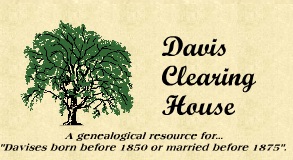
|
Fascinating Stories Return Home |
Interesting information of the first known Davis to settle in America:Capt. James Davis was commander of the fort established at the mouth of Kennebec River 19 August 1607. He was also member of the Council of the New Colony.
27 June 1611, Fort Algernon was visited by some Spanish vessels who ordered Capt. James Davis to surrender. Capt. Davis told them to "go to the devil" then ambushed the Spaniards and captured their leader. Fort Algernon was burned to the ground but "it being the most plentiful lest place for food he used such expedition in rebuilding of the same again that it was almost incredible." At the close of the Administration in 1616, Sir Thomas Dale, Capt. James Davis had command of the colonists in HENRICO (VA Mag. Vol. III, p. 411). Source: Seventeenth Century Isle of Wight, pg. 434, by John Bennett Boddie "When the ships departed, Davis arived in a smal Pinnace with some 16 proper men more; to those were added a company from James Towne under the command of Captain Ratliffe, to inhabit Point comfort. The day before Captaine Smith returned (about 04 Oct 1609) for England with the ships, Captaine Davis arrived in a small Pinace, with some sixteene proper men more: To these were added a company from James towne, under the command of Captaine John Sickelmore alias Ratliffe, to inhabit Point Comfort.
ref: Narratives of Early Virginia 1606-1625 edited by Lyon Gardiner Tyler, LLD, President of the College of William and Mary, Charles Scribner's Sons, New York, 1907, p. 200, 294, 320-321. How piracy helped establish William and Mary College:top In the year following the proclamation, pirates robbed householders in the Isle of Wight County, on the south shore of the James River, and later in 1685 Governor Howard executed the chiefs of "some pilfering pirates [that] have done damage to the inhabitants." Evidently, considerably more unreported plundering was done, for in 1688 a small ship was captured in the James River, containing four pirates with their cash booty, on their way to "retire" in the Colony. They were three white men and a Negro, Peter Cleiss, the servant of the captain of the pirates, Edward Davis. The retirement sum of the three white pirates amounted to wealth: 1,900 Spanish pieces of eight worth a total of £475, plus three bags of uncounted cash. In addition, they had more than four hundred pounds of assorted silverplate (exceeding even William Fitzhugh's collection), along with cloth, linen, lace, ribbons and four pairs of silk stockings. Their interminable trial took a strange turn. Cleiss talked freely of many pirate exploits in faraway places during his nine years with Davis, and soon he was listed by Captain Davis as "a Negro since dead." After he died - he was probably murdered as an informer - the three white pirates changed their pleas of innocence and petitioned for inclusion in the King's proclamation which offered pardon to pirates who surrendered and gave security for their future good behavior. The Virginia General Court claimed they had not surrendered and only petitioned after they were captured. The well-connected pirates engaged the services of Micajah Perry to represent their case to the Lords of Trade, and in 1690, during Nicholson's first term, they were shipped at their own expense to England for trial. As the trial dragged on, several of their accusers died, and though DAVIS revealed familiarity with Virginia, proof was lacking for any specific robbery in Virginia which would not come under the legal definition of "Piracy" on the seas. In 1691 the Lords of Trade freed the "great villains" (as Governor Howard had called them), who immediately began to petition for the restitution of their retirement fund. William III ordered their property returned, with the provison that £300 be subtracted, to be applied to the building of William and Mary College. A story goes that James Blair promised to use his influence to get their property restored if they donated a sum to the new college. In any event, "Davis, Delawafer and Hinson" were listed as contributing £300 to William and Mary College. ref: The Virginia Dynasties by Clifford Dowdey, 1969 p. 188-189. More tales of Pirate Edward Davis - Sailing with Captain Cook:topCaptain Edward Davis. Buccaneer and pirate. Flourished from 1683-1702. According to Esquemiling, who knew Davis personally, his name was John, but some authorities call him Edward, the name he is given in the "Dictionary of National Biography."
Deciding to return to the West Indies with their plunder, several of the crew, who had lost all their share by gambling, were left, at their own request, on the Island of Juan Fernandez. Davis then sailed round the Horn, arriving safely at Jamaica with a booty of more than 50,000 pieces of eight, besides quantities of plate and jewels. At Port Royal, after he had accepted the offer of pardon of King James II, Davis sailed to Virginia and settled down at Point Comfort. We hear no more of him for the next fourteen years, until July 24th, 1702, when he sailed from Jamaica in the "Blessing" (Captain Brown; twenty guns, seventy-nine men), to attack the town of Tolu on the Spanish Main, which was plundered and burnt. Davis next sailed to the Samballoes, and, guided by the Indians, who were friendly to the buccaneers, but hated the Spaniards, they attacked the gold-mines, where, in spite of most cruel tortures, they got but little gold. The crew next attacked Porto Bello, but found little worth stealing in that much harassed town. Davis is chiefly remarkable for having commanded his gang of ruffians in the Pacific for nearly four years. To do this he must have been a man of extraordinary personality and bravery, for no other buccaneer or pirate captain ever remained in uninterrupted power for so long a while, with the exception of Captain Bartholomew Roberts. ref: The Pirates' Who's Who; Giving Particulars of the Lives & Deaths of the Pirates & Buccaneers by Philip Gosse, 1988, The Rio Grande Press, Inc., Glorieta, NM, 87535 p. 104-105. Pirate Davis Sails with Captain Kidd:topCaptain William Kidd was born in Greenock, Scotland, about 1645 the son of a Presbyterian minister. ....it is not until 1689, when he was about forty-four years old, that he appears in the records. By that time he had found his way to the Caribbean, where he was a member of a buccaneering crew. p. 27. Little is known about most of the other new men with Kidd. One was John Harrison, who desired to return to his home on Long Island; another was John Hales, who wanted to retire to London and open a victualing house; and another was the intriguing Edward Davis, an "extraordinary stout man". This is undoubtedly the Edward Davis who captained the "Batchelor's Delight" on its return to the Caribbean. He ultimately fled north to Virginia, where he and his companions were caught rowing across Chesapeake Bay. After a long and tedious legal struggle the men won their freedom and even recovered their treasures, minus £300 used toward founding a new college in Virginia --the present day William and Mary. After collecting his booty, Davis vanished for a few years until he reappeared in 1697 as a crew member on the "Fidelio", with Tempest Rogers as captain, bound for the Indian Ocean. One voyage was enough for Davis, who ended up on Saint Marie seeking passage home just as Kidd prepared to depart. p. 164
Oldys then asked for a delay of Kidd's trial for piracy until Edward Davis, who had seen the two passes, and the passes themselves, were produced in court. p. 213. Instead Kidd called Edward Davis, whom he expected to verify the existence of the passes. Davis admitted to having seen the passes, although he never examined them and did not know their relation to any particular ship. After this disappointing testimony Kidd wanted to call character witnesses, to which Justice Ward replied, "If all the defense witnesses were like Davis the prosecution could sit back and relax." p. 218 ref: Captain Kidd and the War Against the Pirates by Robert C. Ritchie, Harvard University Press, Cambridge, MA, 1986. #3569 Mon Jan 22 to Thur Jan 25, 1699/1700. Boston, in New-England, Nov 29. The Earl of Bellomont, our Governor, continues his Care and Vigilance for discovering and Seizing the Pyrates that are come into these Parts. One Gillam, a pirate who had raided in Rhode Island was captured Nov 13 and prisoned. He was for several years a pirate in the South Seas and afterward on board the "Mocha" Frigate in India, murdered Capt. Edgecombe the commander and debauched the Seamen, then turn'd Mahometan and served the Mongul, and since committed several other pryacies and villanies. His Lordship being likewise informed that Joseph Bradish and Tee Wetherly, two of the chief pyrates that run away some time ago with Capt. Gullock's ship had taken refuge among the Indians, and were at one of their forts about 200 miles to the Eastward of this place, he prevailed with the said Indians by giving them a reward of 300 Pieces of Eight to deliver up the said pyrates, who were accordingly brought hither Prisoners. And besides these three, and Capt. Kid and CAPT. DAVIES taken some time ago, there are at this time 15 or 16 more in the Gaol (jail) of this place. ref: "The London Gazette" Family Puzzlers April 1, 1989 #1067 p 7 top |
|
|
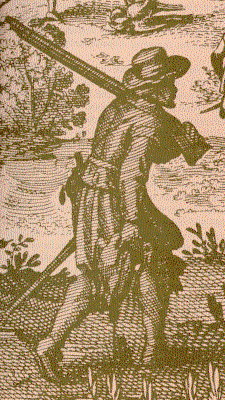 Capt.
John Smith mentions Capt. James Davis as among the leaders and councilors of
the New Colony. Governor George Percy describes an expedition led by Capt. James
Davis, (quote) "an easie foote man" which I interpret as meaning a
good infantryman, with most of the soldiers. Capt. Davis put to flight the Indians
who attacked him; marched about 14 miles into the interior, cut down the corn
of the Indians, burned their houses, temples and idols., etc.
Capt.
John Smith mentions Capt. James Davis as among the leaders and councilors of
the New Colony. Governor George Percy describes an expedition led by Capt. James
Davis, (quote) "an easie foote man" which I interpret as meaning a
good infantryman, with most of the soldiers. Capt. Davis put to flight the Indians
who attacked him; marched about 14 miles into the interior, cut down the corn
of the Indians, burned their houses, temples and idols., etc. About this time (18 June 1614) it chanced a Spanish ship, beat too and againe before
point Comfort, and at last sent a shore their boat, as desirous of a Pilot.
Captaine James Davis the governor, immediately gave them one; but he was no
sooner in the boat, but a way they went with him, leaving three of their companions
behind them; this sudden accident occasioned some distrust, and a strict examination
of those three thus left, yet with as good usage as our estate could afford
them."
About this time (18 June 1614) it chanced a Spanish ship, beat too and againe before
point Comfort, and at last sent a shore their boat, as desirous of a Pilot.
Captaine James Davis the governor, immediately gave them one; but he was no
sooner in the boat, but a way they went with him, leaving three of their companions
behind them; this sudden accident occasioned some distrust, and a strict examination
of those three thus left, yet with as good usage as our estate could afford
them."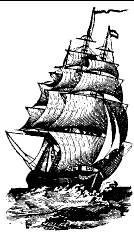 In
1682 a pirate ship had landed at the mouth of the York River and its crew sacked
two plantation homes, taking silver plate and cash as well as victuals. Until
then, the colonists had traded with the pirates, but in 1684, a proclamation
prohibited "the King's" subjects from trading, harboring or corresponding
with the pirates.
In
1682 a pirate ship had landed at the mouth of the York River and its crew sacked
two plantation homes, taking silver plate and cash as well as victuals. Until
then, the colonists had traded with the pirates, but in 1684, a proclamation
prohibited "the King's" subjects from trading, harboring or corresponding
with the pirates.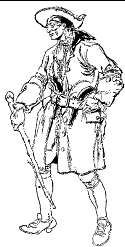 In
1683 Davis was quartermaster to Captain Cook when he took the ship of Captain
Tristian, a French buccaneer, of Petit Guave in the West Indies. Sailed north
to cruise off the coast of Virginia. From there he sailed across the Atlantic
to West Africa, and at Sierra Leone came upon a Danish ship of thirty-six guns,
which he attacked and took. The pirates shifted their crew into this ship, christening
her the "Bachelor's Delight", and sailed for Juan Fernandez in the
South Pacific, arriving there in March, 1684. Here they met with Captain Brown,
in the "Nicholas", and together sailed to the Galapagos Islands. About
this time Captain Cook died, and Davis was elected captain in his place. Cruising
along the coasts of Chile and Peru, they sacked towns and captured Spanish ships.
On November 3rd Davis landed, and burnt the town of Paita. Their principal plan
was to waylay the Spanish Fleet on its voyage to Panama. This fleet arrived
off the Bay of Panama on May 28th, 1685, but the buccaneers were beaten and
were lucky to escape with their lives. At the Gulf of Ampalla, Davis had to
put his sick on shore, as spotted fever raged amongst the crew. Davis then cruised
for a while with the buccaneer Knight, sacking several towns.
In
1683 Davis was quartermaster to Captain Cook when he took the ship of Captain
Tristian, a French buccaneer, of Petit Guave in the West Indies. Sailed north
to cruise off the coast of Virginia. From there he sailed across the Atlantic
to West Africa, and at Sierra Leone came upon a Danish ship of thirty-six guns,
which he attacked and took. The pirates shifted their crew into this ship, christening
her the "Bachelor's Delight", and sailed for Juan Fernandez in the
South Pacific, arriving there in March, 1684. Here they met with Captain Brown,
in the "Nicholas", and together sailed to the Galapagos Islands. About
this time Captain Cook died, and Davis was elected captain in his place. Cruising
along the coasts of Chile and Peru, they sacked towns and captured Spanish ships.
On November 3rd Davis landed, and burnt the town of Paita. Their principal plan
was to waylay the Spanish Fleet on its voyage to Panama. This fleet arrived
off the Bay of Panama on May 28th, 1685, but the buccaneers were beaten and
were lucky to escape with their lives. At the Gulf of Ampalla, Davis had to
put his sick on shore, as spotted fever raged amongst the crew. Davis then cruised
for a while with the buccaneer Knight, sacking several towns.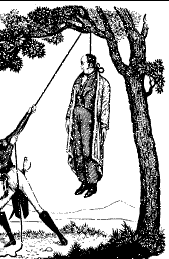 Kidd's
trial started on 08th May 1701 and was over on May 9th. In those two days the
prisoner was tried and convicted of murder and multiple piracies. p. 206.
Kidd's
trial started on 08th May 1701 and was over on May 9th. In those two days the
prisoner was tried and convicted of murder and multiple piracies. p. 206.